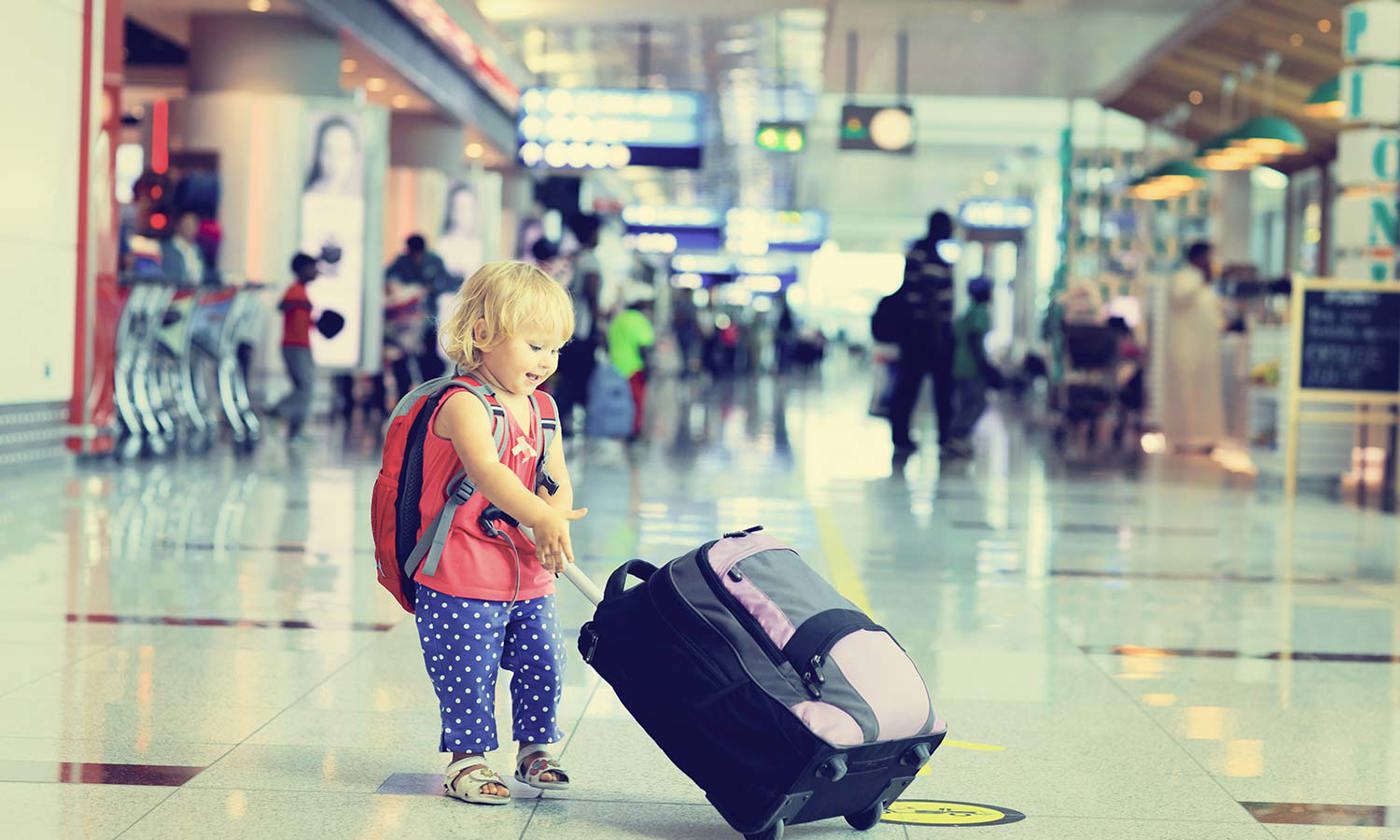Like what you see?
Sign up to receive more free parenting advice.
Thank you for subscribing to our newsletter!
Lifestyle

Credit: iStock.com/Nadezhda1906
Should you travel with the kids? Of course! But knowing what will work for your child’s age and stage will help make the experience enjoyable for all.
Travel with an infant
For most first-time parents, travelling with an infant seems daunting at best. It’s true there is plenty to consider, but there’s good news too. If your baby is sleeping reasonably well (for his or her age) and feeding is under control, then this can be an excellent time to travel.
Babies primarily need food, sleep and love: if you are with them, they can have that almost anywhere. If your baby is not yet crawling, you’ll find if you time it well you can enjoy cultural experiences like museums and galleries longer now than with your toddler or even pre-schooler.
Prepare for the flight: then stop worrying
Most parents worry about flying with their baby. It’s true it’s a whole new world, but remember the time on a flight is just a small proportion of your trip. Plan well for the flight, then try not to stress. Pack extra nappies and outfits (including extra clothes for the adults, in case you’re the unintended victim of an overflowing nappy) and if your child is on solids, take food rather than relying on what you can get in flight.
For many parents, a baby carrier is incredibly handy for flights. You can use it to settle them by walking up and down the aisles, and to move through the airport easily. You’ll need to take your baby out of the carrier when passing through customs, so if possible, time sleeps accordingly.
In flight, try to feed (bottle or breast) during take off and landing; this helps babies unblock their ears.
Make transfers easy
One of the hardest things about travel with a baby is the mountain of equipment you’ll be lugging. By the time you pack a pram, travel cot, nappies and blankets, you might be carrying the equivalent of a B-grade celebrity’s luggage. Happily, airlines are generous with infant luggage allowances (usually you won’t pay to check a pram, travel cot or car seat), but it does mean you’ll want to invest in easy transfers on arrival. Private transport is often easier than public transport at this stage for transfers; look for options with baby car seats.
Try to maintain routines
Flights aside, it’s worth trying to keep your baby in a routine of sorts while travelling. If they are on two day-sleeps, figure out which one they’ll cope with in a pram or carrier, and consider sticking to the travel cot for the other one. Alternating ‘active’ days with ‘lazy’ days provides recovery time on a longer trip, and in terms of dining, take snacks everywhere (yes, everywhere) as dining in restaurants isn’t usually baby friendly. Picnics or buffets are fantastic dining solutions at this stage – the former for the chance to move around, the latter for the speed.
Travel with toddlers
It’s true: toddlers’ unpredictability in both temperament and behaviours can occasionally make them tricky travel companions. But this doesn’t mean you should stay home for two years. Instead, accommodate your toddler by choosing the right activities and location and you’ll be able to continue exploring the world together.
Flying with a toddler
There’s no cushioning this: flying with a toddler is rarely easy. If there’s a time to keep flights short (say under three hours), it’s now. If you are using screen time this will make flying much easier. For those who don’t, arm yourself with toys, books and be ready to entertain them for the bulk of the flight. Walking the aisles is an excellent distraction for a younger toddler: bored passengers usually smile and wave as you do laps of the plane.
In good news, if your flight starts and ends before your toddler’s second birthday, they’ll usually fly free. The downside? They don’t get their own seat until you pay for it.
Choose your destination wisely
Many toddlers don’t do particularly well in cities (you’ll be constantly on the lookout for playgrounds) but they usually love the beach or anywhere in nature, where they display the enviable skill of being able to entertain themselves for hours. Invest in a good bucket, spade and dump truck for the beach, and consider taking a swim vest or life jacket for any water-based destinations. Farm stay holidays are also a hit with toddlers.
If you are in a city, take comfort in the fact that bus, train and ferry journeys are usually greeted with excitement by toddlers, making getting around fairly economical.
Preschoolers
By this stage, some things about family travel become exponentially easier. Preschoolers are (sometimes) rational, (occasionally) patient and (always) inquisitive, making them rewarding travel companions.
Flying with a pre-schooler
Flying starts to become easier with preschoolers. They are excited about planes, able to sit still, and – if you cater to them well with books, activities and snacks – can be very good flyers. If you’re still using nappies overnight you might want to consider using them on long plane rides. This makes life easier if the seatbelt sign is on when they ‘suddenly’ need to go. In-seat entertainment means it’s also almost impossible to avoid screen time at this age; many parents toss out the rulebook and let preschoolers watch the screen during the flight.
Activities for everyone
Preschoolers are still enamoured with playgrounds, so seek these out whenever you can. They’re also obsessed with the beach (take plenty of things to dig with), enjoy bike riding on their own or on the back of your bike and, depending on the child, may be able to tackle shortish bushwalks. You’ll often find their motivation for the latter depends on who is with them (kids walk a lot further with other kids to run along with), or on what inducement they have to complete the walk.
Be prepared to carry your preschooler for at least part of the way.
Although they can still have a short attention span in a museum, preschoolers love kid-friendly theatre productions and shows; both are high impact ways to add some more formal cultural experiences back into your travels.
Insider Tips
Need a packing hack?
Packing cubes (zip up fabric containers, usually with netting on one side) make identifying undies easy if family members are sharing a suitcase. Buy a different coloured set of cubes for each family member, and label them with ‘tops’, ‘bottoms’ and ‘personal’ to make grabbing the right item even faster (coloured key tags are good for the labels).
Slash your accommodation costs
Consider joining a house swap site. These are excellent for families and, once you’ve paid your annual membership fee, they’ll take your accommodation costs down to zero. Often you can even swap cars! Aussie House Swap and Home Exchange are two reputable options.
Sleeping arrangements: size matters
If booking online, often platforms like Booking.com will tell you the square metreage of your room if you drill down to the room’s floor plan. It’s a useful hack if you need to fit in a travel cot or ensure there’s space for kids to play.
Hoard frequent flyers
Once you are paying for a child’s seat, don’t forget to register them for a frequent flyer account. Many frequent flyer programs allow you to transfer point totals between family members.
Worried your baby will spill food on Aunt Mabel’s floor?
If you’re on a road trip with boot space to spare (or have plenty of luggage allowance) consider packing a cheap shower curtain. Seriously - put it below their high chair at mealtimes and it will save messing up the floor (excellent if there’s carpet). A less radical, but similarly effective, solution is to take a silicone bib with a ‘catcher’ at the front.
Take advantage of priority queues
When travelling with kids, always look out for ‘kid-friendly/special assistance’ lanes at immigration/customs. Each country has variations on this theme: in Paris, parents with babies get whizzed to the front of taxi queues. Conversely: if flying with a very young baby, reconsider the need to board early. Usually, it’s better to board late and minimise the time you are seated. (For slightly older kids the reverse applies: the extra time helps them get settled.)





